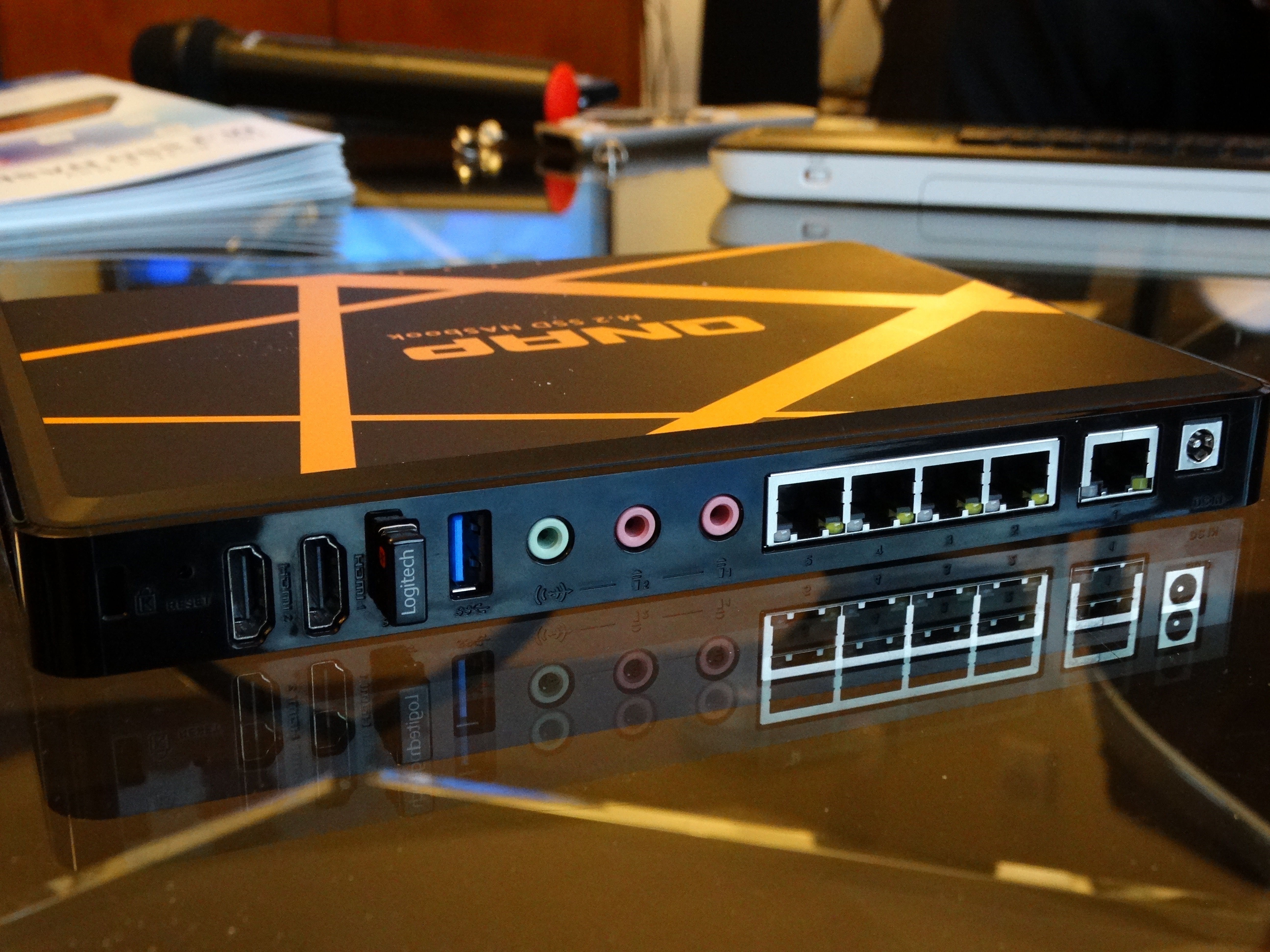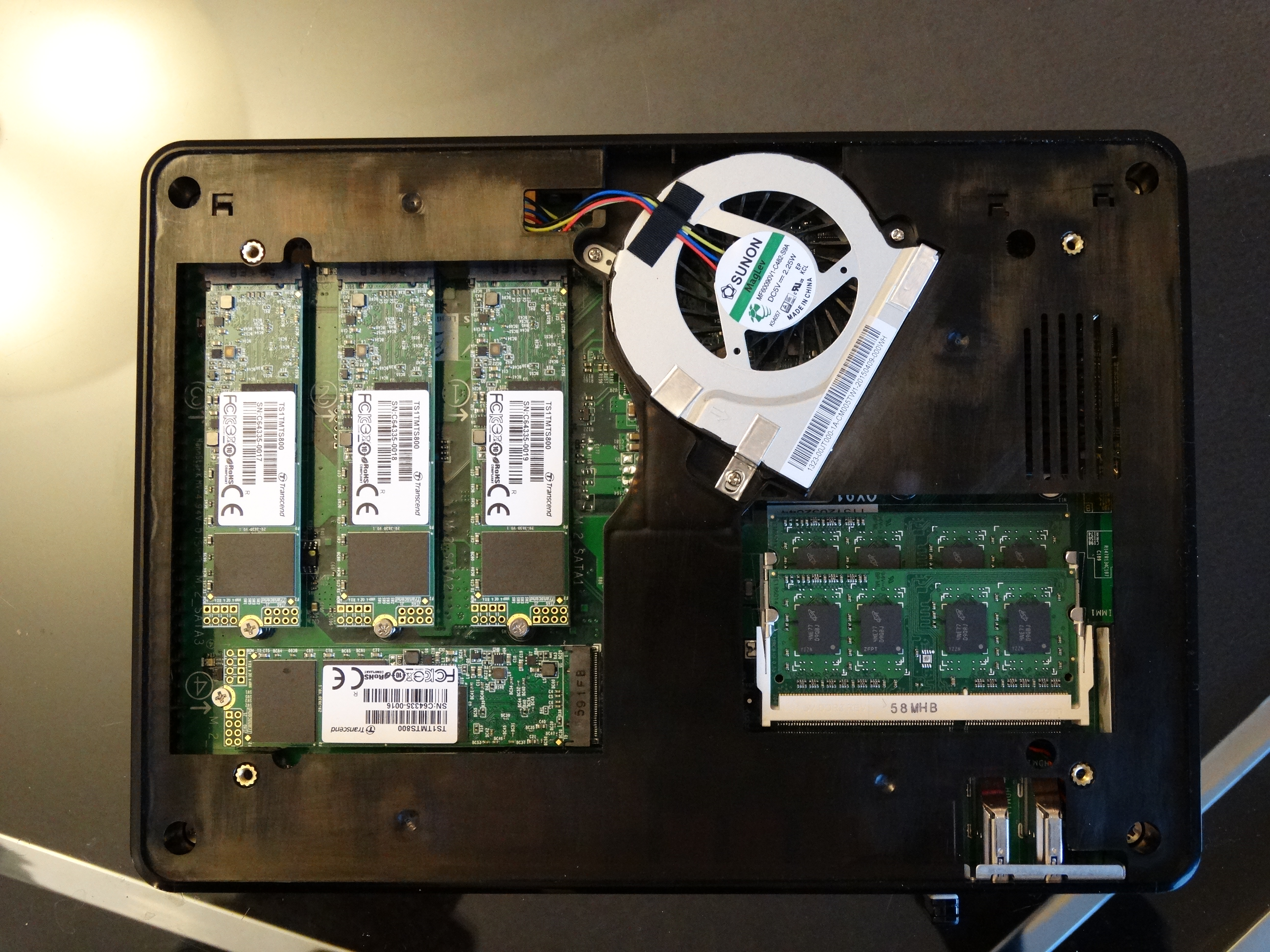The QNAP TBS-453A Changes The NAS Game
This was a breakout year for QNAP. The company released several new products in multiple form factors, brought new exclusive software features and has yet to find the brake pedal. Case in point is the new TBS-453A, aka the NASbook.
The TBS-453A isn't QNAP's first slim desktop form factor NAS appliance, but it is the first to add network switching and four disk drive support. The NAS product segment has evolved over the last decade from a pure storage play to devices that sit in the middle of your digital life. The NASbook takes all of those elements and joins them in one small, easy to manage device.
The front of the system looks like a refined gaming console or exaggerated set-top box like your cable or satellite TV provider would supply. There are a few buttons, a pair of USB ports and a card reader. The button on the far left handles the one-touch copy function. When you plug in a device such as a cell phone, USB drive or possibly an SD card and press the button, the data is backed up to the NAS.
Things get a little more interesting and unique on the back. Dual HDMI ports and audio I/O connect to your monitor or TV. The system can run as an independent computer with QNAP's existing software package that supports Windows, Linux and other operating systems. Users can also use the ports in conjunction with KODI or other multimedia front end software that turns the system into a full-on media center. Audiophiles and users of high-end home theater products will appreciate the dual HDMI ports for connecting more than one device to the system.
There are five network switching ports that can be assigned via a new software module. This is essentially software-defined switching, a new carryover from the enterprise universe where software-defined everything has gained traction. Now your TV, DVR, gaming console and other theater equipment can link directly to your storage.
And oh, what great storage it is! To keep a slim profile, QNAP enabled four M.2 SATA storage ports (with the 2280 form factor). We suspect the system will be very fast, even when distributing several 4K videos through the network. The Intel Braswell quad-core processor enables the system to stream multimedia files to other network devices and even mobile drives like tablets at remote locations.
SanDisk's new X400 M.2 SSD that measures only 1.5 mm thin recently launched with the company's X3 NAND flash (TLC) in 1 TB capacity. The drive should offer great performance for a low-cost NAS SSD.
Get Tom's Hardware's best news and in-depth reviews, straight to your inbox.
QNAP didn't have a firm release date for the new TBS-453A, but we suspect it will ship later in 2016. The hardware appears retail ready right now. Also, the major components in the system are standard parts used in other NAS products already shipping, like the TS-453A.

Chris Ramseyer was a senior contributing editor for Tom's Hardware. He tested and reviewed consumer storage.
-
CaedenV This is amazingly awesome and amazingly pointless at the same time! The big issue here of course is Gigabit Ethernet... even ganging all 4 ports together with a single connection is only going to net you a total of 400MB/s, which is a speed that 2 HDDs in a RAID1/0 (or a single SSD) can easily saturate in throughput.Reply
To really make this shine you need a bunch of 10Gb/s ports... and even then the SSDs would be bandwidth capped.
Still, amazing to see all of that m.2 connectivity though! I bet IOPS throughput is pretty awesome on this kind of box, which would be handy if you have lots of users hitting it at the same time. -
Darkk I agree. 10Gb network port would have been better but there will always be overhead with the network.Reply
-
Hanin33 It's a great proof of concept and way to get this type of device going in the consumer market. The issues of questionable connectivity will be addressed in future revisions, and let's be honest, the majority of buyers will not be the kind that will saturate the current connections. Let them sell these and get support going and watch for versions that meet the needs of even the top end, maybe through modular connectivity.Reply -
infusednz 10gb network is stupid. Requires a very expensive back plane and a huge amount of CPU. Get real guys.Reply -
Vorador2 Reply10gb network is stupid. Requires a very expensive back plane and a huge amount of CPU. Get real guys.
Is almost as worse to install an array of M.2 SSD and only add 1 Gb ports, you're essentially wasting that pricey SSD storage. The overhead added by TCP/IP AFAIK squanders the high I/O and the max throughput of the 1 Gb ports doesn't even approaches 1/10 of the total bandwidth of a good M.2 SSD. QNAP should have had the option of replacing the port module for a 10 Gb one, or at least one of them. -
hef311 It's a product for the home - who has 10Gb Ethernet at home, much less needs it? Streaming an HD movie only requires what, 2-4MB/s? Not sure why one would put an SSD in a home NAS. Even video transcoding / converting is going to be CPU-heavy, not I/O heavy.Reply -
tinnerdxp I agree - it should support normal hard drives, there's no point in spending extra money on 4 x SSDs just to keep the box quiet and small... The 10Gb ports would also be useful and in terms of CPU power - it seems like it could handle that.Reply
Interesting proof of concept - but it won't fly in a real life. -
blazorthon If you have many users who each only need say 4MB/s, then hard drives would struggle whereas SSDs would not. Gigabit Ethernet would also still be sufficient even without using ganging, so 10GbE would be unnecessarily expensive and would require the clients to also support 10GbE, which isn't likely in the home. The product has its uses as it is, though I can't help but feel that two 2.5" slots would have been better since you could then choose to use HDDs or SSDs, depending on which better suits your needs.Reply
Something like making the Ethernet ports be through a replaceable module that could be switched out with a 10GbE version would be a nice touch too, but I doubt many people would do something like that and it might be easier to just later make a 10GbE version of the NAS for such customers. -
Patrick_1966 I think that the question of the Disks being saturated is moot. 4K resolution only requires about 25Mb/s throughput (Saw the calculation done somewhere...) so four channel at that level gives 100 / Mb / second required and one of the posters above indicated the 4 port can produce 400 Mb/Second. Given other issues on the network and contention for the HD's plus protocol overhead etc etc etc... 4 Gigabit ports BONDed should be sufficient to cover two standard deviations of use (95%). 10Gb would only be useful for a 3-standard deviation market (99.7%). Yes I know a probability curve is not exactly am accurate reflection of use but it gets the point across that this is designed for a market with a certain normal distribution of use cases.Reply -
blazorthon Using four GbE ports to connect to a single other device is rather extreme. The only things it could then connect to are routers/switches with even more ports or computers with four ports. Both are expensive and unlikely to be found in a typical home, so whether or not it is enough for (using your measurements) two standard deviations is irrelevant because most of that 95% couldn't or wouldn't use such a configuration.Reply
Basically, anyone who wants to use this as high speed network storage is going to be disappointed and anyone who doesn't want high speed network storage doesn't need it to have four SSDs. 2.5" bays would have made more sense than SSD only slots.


